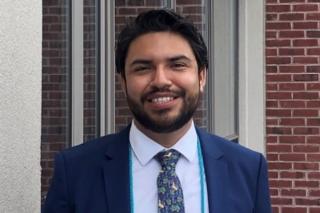What the job entails
Adam is a medical/surgical inpatient social worker at Mount Auburn Hospital in Cambridge. He works closely with an interdisciplinary team to provide support to patients hospitalized on the medical and surgical floors, some of whom are assessed for and connected to oncology, geriatric, and palliative/hospice care upon discharge.
Working in both English and Spanish, he conducts assessments for social supports and home/community safety; collaborates with case management; and assists the medical team in communicating with patients and families about treatment options and goals.
“In a teaching hospital like Mount Auburn,” he says, “the medical providers may change, but the social workers are the constant.”
What brought him to Simmons
A graduate of Northern Arizona University with degrees in international affairs and Spanish, Adam chose Simmons for its small class size and close-knit community.
“When I visited,” he says, “I found the professors to be approachable and authentic. I knew that they would help me explore social work through great conversations.”
He also appreciated Simmons’s location in a “unique, rich city” and major medical hub.
How Simmons prepared him
Pursuing a certificate in Health Care & Social Work, Adam completed targeted coursework that he now “draws on daily,” he reports. His first placement was at the Codman Square Health Center in Dorchester, where he handled case management for patients with wide-ranging needs. In his second year, he received specialized training in integrated behavioral health for medically underserved and vulnerable populations in the Simmons Integrated Mental Health Primary Care and Clinical Training (SIMPACT) program. As a SIMPACT scholar, Adam interned in the primary care and outpatient cognitive neurology departments at Beth Israel-Deaconess Medical Center in Boston. There, he provided short- and long-term psychotherapy, collaborated on treatment plans, and co-facilitated support groups for patients with chronic illnesses.
In addition, as part of a social action course taught by Professor Hugo Kamya, Adam spent three weeks in Uganda. “Simmons prioritized my goals for my education,” he says. “I received excellent training.”
Why it’s rewarding
Adam follows patients throughout their treatment course, from admission to discharge. “I become the vehicle for communication and support to the patient and the medical team,” he says. “It’s a privilege to get to know a patient so well—to present who this person is and to advocate for the best possible care.”

